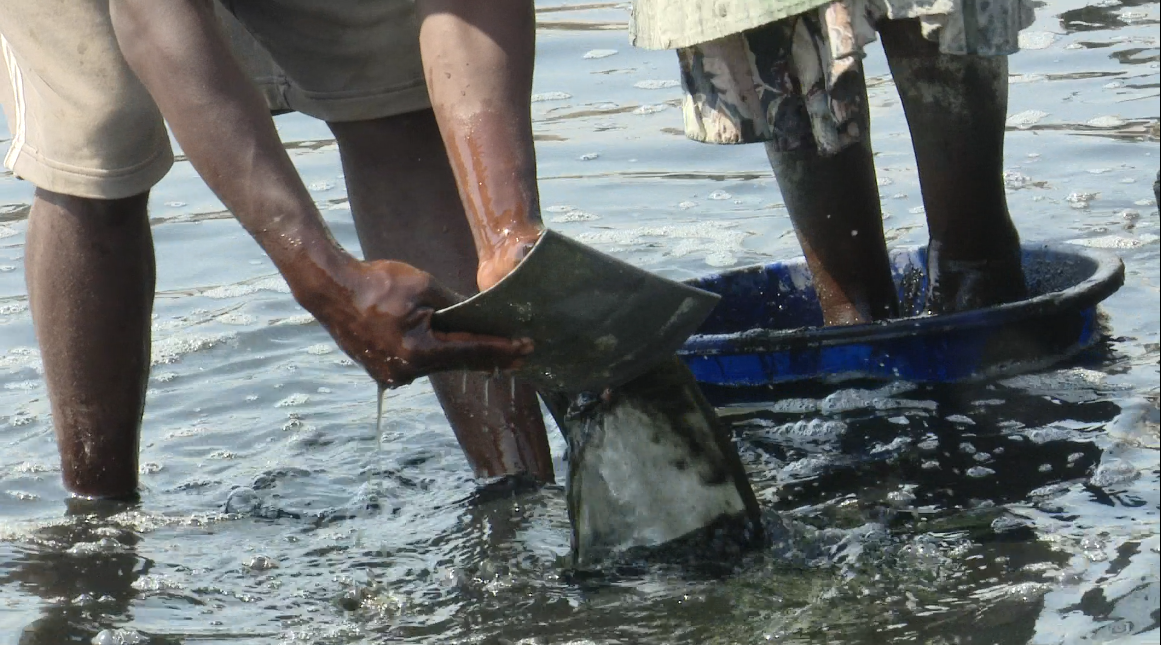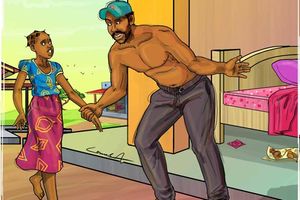Prime
Death of Maj Gen Rwigyema

(Right)The coffin of the late Maj Gen. Fred Gisa Rwigyema at the home of his widow Janet Rwigyema in Kigali. Rwigyema who was killed on October 2, 1990, just one day after his army the Rwanda Patriotic Army (RPA) invaded Rwanda, was given a heroes burial at the heroes corner in Remera, a Kigali suburb, (Left) An illustration of the first chairman and commander-in-chief of the Rwanda Patraa. PHOTO BY LAURA MULENGA.
What you need to know:
Leader. Maj Gen Fred Rwigyema, the man who led the Rwandan refugees on their journey back home on October 1, 1990 was, in many ways, like the Biblical Moses who led the Israelites from exile in Egypt. Both men fought for and defended their people while in exile and both never reached home alive. Both men stood at the hill, saw home and there they died. In this third part of our series on the Rwanda Invasion, we trace circumstances surrounding his death in the first days of the war.
Kampala
Mysterious and death seems synonymous with the generals. Is it accidental or coincidental? In Europe, the death of Napoleon the Great and Adolf Hitler have remained inexplicable to this day. John Garang and Samora Machel are African great generals whose deaths remains mystical to the world. Here at home, the deaths of Maj Gen David Oyite Ojok, Maj Gen James Kazini, etc remain a mystery.
So is the death of the first chairman and commander-in-chief of the Rwanda Patriotic Front/Army (RPF/A) Maj Gen Fred Rwigyema in the second day of the Rwanda invasion on October 2, 1990.
On that day, the RPA encountered heavy fire and Rwigyema was sending a radio message for reinforcement when a sniper shot him dead, was the RPF statement issued to the press in Kampala a month after his death. His death was kept a secret for a month for fear that the fighters would lose morale and desert the war.
There had been an earlier version – apparently extracted from RPF fighters captured by Rwanda army and broadcast on government radio in Kigali – that Rwigyema died when he stepped on a landmine. However, in mid-October, the Kigali radio disputed that version and insisted that Rwigyema was killed by the government forces. This was after the Forces Armee Rwandaise (FAR) the government forces had taken more RPA prisoners of war (POW), four of whose pictures were published in the media in Kigali and later Kampala.
The POWs claimed that they were picked from Kabale District of Uganda and had been abducted and forced into the RPF ranks when the war started. Thus it was the Kigali radio that broke news of Rwigyema’s death before the press in Uganda on November 5, 1990. It is believed though that senior Uganda military and government officials got the sad news on October 5 after the first fighters deserted the war and returned to Kampala and reported the incident to a major general friend of late Rwigyema and others.
The other popular theory is that Rwigyema was assassinated by his deputy Maj Peter Baingana (a doctor) in the company of Maj Chris Bunyenyezi over the command of the RPF and shortly Rwigyema’s aide de camp; Capt Kaitare commanded the execution of the two in vengeance.
However, this sounds like another conspiracy theory. Because, on October 8, Maj Baingana, Maj Sam Kanyemera Kaka, Lt Godfrey Byegyeka and Capt Kaitare met journalists at Kagitumba border. A freelance journalist, Cathy Watson, had an exclusive interview with Baingana for the BBC radio and her story was also published by the Weekly Topic newspaper in Uganda.
According to her story, when asked about Rwigyema’s whereabouts, the four RPF fighters told her that he was somewhere on the front-line. Maj Baingana was last photographed on October 14 by the Weekly Topic, inspecting a captured Armoured-Vehicle at Gabiro 49km from Kigali and 65km from Kagitumba post.
In war, propaganda is as vital as the weaponry. After the killing of two Front for National Salvation (FRONASA) fighters Martin Mwesiga and Wunku Mpima in Mbale in January 1973 by the Uganda Army as their leader Museveni narrowly escaped, he was wrongly accused by his detractors of having killed his fighters. Museveni was, however, exonorated by the truth revealed in the 1980 committee and the 1988 Commission of Inquiry into the violation of human rights in Uganda since 1966.
So how did Baingana and Bunyenyezi die? The RPF/A said the two died on October 23, 1990 as they travelled to Nyagatare from Gabiro to reinforce the fighters at the frontline. In a war theatre, anything can happen. It can be accidental even deliberate. For instance, during the Luweero war tempers would flare and bubble.
On page 146, in ‘Sowing The Mustard Seed’, President Yoweri Museveni wrote of a bitter row amongst the NRA fighters: “Distrust had arisen out of contradictions and disagreements over operations, but the main problem had been caused by the execution of a boy called Shaban Kashanku for going to Kampala without permission. The trial had not followed the proper procedures involving all the people concerned, and had therefore caused a lot of fear and suspicion within rank and file. Some commanders were afraid to go out for operations for fear that they would be ‘shot in the back’”.
It is not clear how many were ‘shot in the back’ during the NRA bush war. So why could Baingana and Bunyenyezi die in an ambush on the same day, same spot only separated by hours? Were they ‘shot in the back’ or did they die from a booby trap? The two majors died shortly after Major Paul Kagame had been recalled to Rwanda from a military course in USA which he abandoned to take charge of the war.
On October 15, the RPF had accepted a ceasefire. Faced with the death of Rwigyema, superior enemy aerial fire and international pressure exerted on Uganda, RPF needed breathing space to reorganise, analysts say. From the front-line, on October 31, Kagame joined Pasteur Bizimungu on the delegation in the first RPF-Kigali government ceasefire meeting held in Mbarara Town in south western Uganda.
Zaire’s [now Democratic Republic of Congo (DRC)] ambassador to Uganda, Nzapa Kengo represented President Mubutu Seseko who was the initiator of the peace talks. Earlier on October 26, 1990 President Museveni, Buyoya of Burundi, Mubutu of Zaire and Habyarimana of Rwanda had met in
Gbadolite, Zaire to off-set the cease-fire talks between the RPF and the Kigali government.
When Ugandan journalist Ogen Kevin Aliro interviewed the RPF chairman Col Alex Kanyarengwe in presence of RPF High-Command chairman, Major Paul Kagame in late June 1991 inside Rwanda and asked him what mistakes RPF/A had made during the war, Kanyarengwe answered: “I cannot say we made any serious errors. Rather we met bad luck at the very beginning. We lost our charismatic chairman, Maj Gen Fred Rwigyema and his two deputies. That affected us.”
Analysts contend that psychologically, if the two had indeed murdered their commander, they would have been seen as enemies of the RPF/A and as such, RPF/A would not mention their names as Kanyarengwe did in the interview with the Weekly Topic of July 5, 1991.
Rwigyema’s death has created a web of intrigue yet to be resolved now 23 years ago. Was he killed by the FAR sniper or was he ‘shot in the back?’ After the war, Rwigyema was given a befitting burial as a hero at Remera Heroes cemetery in Kigali.




